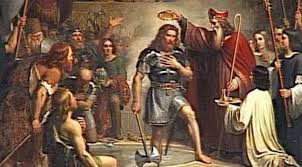An avid reader of both fiction and history, I became fascinated with fifth century France and the world of the barbarian Franks, later called the Merovingians. My curiosity doubled when I discovered a different view of ancient Rome in this period and its interaction with European barbarian tribes. The Roman Empire was on the brink of collapse and into this gap stepped the barbarians. Gregory of Tours, bishop and sixth century historian, wrote in his work, The History of the Franks, of how the Franks rose from tribal chiefs and warriors to the acknowledged masters of Roman Gaul (France).
Fascinated by this era of change and upheaval, I chose late ancient Rome and Gaul as the setting for my novel. I’ve endeavored to represent the events, places, and beliefs as closely to the historical record as possible, but I’ve also added my own interpretation to the lives of all the characters real and imagined.
History and People
By the third century, the Germanic Franks were a federation formed of eleven tribal groups, which included the Salian Franks and the Chamavi. They occupied the territory on the east bank of the lower Rhine valley (known today as Belgium and southern Netherlands) but then as Gaul and into the later centuries as Francia/France. Their political federation does not preclude the possibility that the groups and their chieftains warred as rivals. With this understanding in mind, I created tension between Luthgar’s Salians and Ingobar’s Chamavi, two Frank tribes in my story.
Merovingian, the title given to the Franks, derives from Meroveus/Merovech. Gregory of Tours mentions Meroveus as the son of Chlodio, the first king of the Salian Franks. Around 450, Meroveus went to Rome to gain support from the Romans for succession as king against an elder brother who aligned with Attila the Hun for the same reason. Priscus, a Roman diplomat and historian, wrote of Meroveus, “I have seen him, he was still very young and we all remarked his fair hair which fell upon his shoulders.”
 This statement supports the idea that Frank nobles distinguished themselves from the commoner and other groups by wearing longer hair, despite the fashion, and were called ‘Long-hairs.’ The Roman Master of the Soldiers, Flavius Aetius, welcomed Meroveus and accepted him as a friend and foederatus (Roman subsidized barbarian warrior). The Salian Franks fought with Rome at the Battle of Catalaunum (also known as the Battle of the Catalaunian Plains or Châlons).
This statement supports the idea that Frank nobles distinguished themselves from the commoner and other groups by wearing longer hair, despite the fashion, and were called ‘Long-hairs.’ The Roman Master of the Soldiers, Flavius Aetius, welcomed Meroveus and accepted him as a friend and foederatus (Roman subsidized barbarian warrior). The Salian Franks fought with Rome at the Battle of Catalaunum (also known as the Battle of the Catalaunian Plains or Châlons).
The great Roman general, Flavius Aetius, referred to by some as the ‘last Roman’ is a supporting character in my novel. He served as the Magister Militum (Master of the Soldiers) from 429 to 454 and had a long career as a soldier, general and leader. He won the Battle of Catalaunum against Attila the Hun in 451. After Attila’s death, he diminished in importance. By this time, the emperor, Valentinian III, believed that Aetius conspired to put his own son, Gaudentius, betrothed to Valentinian’s daughter, on the throne. Valentinian, influenced by the ambitious senator Petronius Maximus, felt threatened and stabbed Aetius to death as he read a financial account to him. With Aetius gone, the empire was vulnerable and left without a true defender. In 455, the Vandals sacked Rome.

Wow! This can be one particular of the most helpful blogs We have ever arrive across on this subject. Actually Excellent. I’m also a specialist in this topic therefore I can understand your hard work.
Hello, So sorry to respond so late to your comment!! I’m doing some work on the site and just saw this. It is a wonderful time period that’s gone somewhat unnoticed and it does require a lot of investigation as you may well know. Again, sorry that your comment slipped through the cracks.